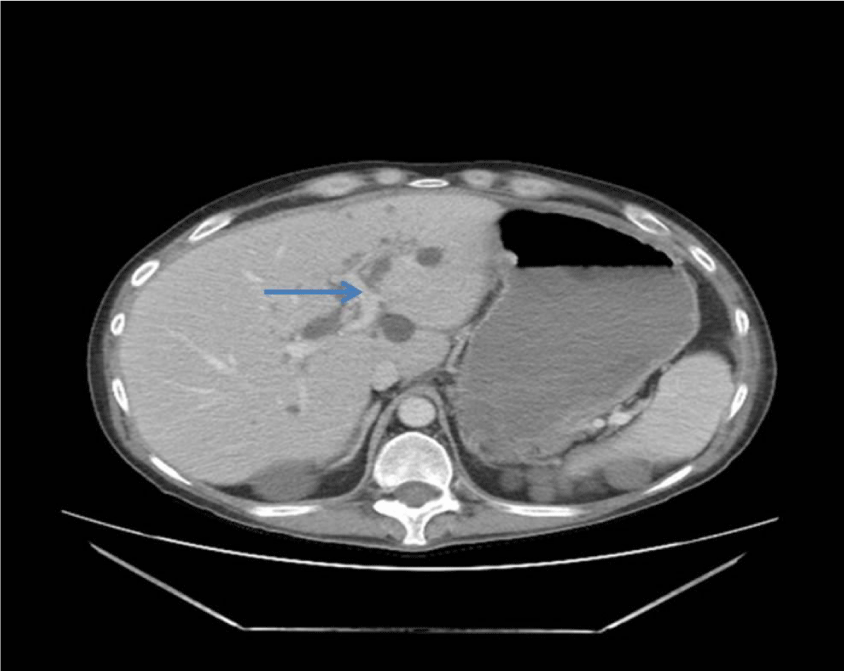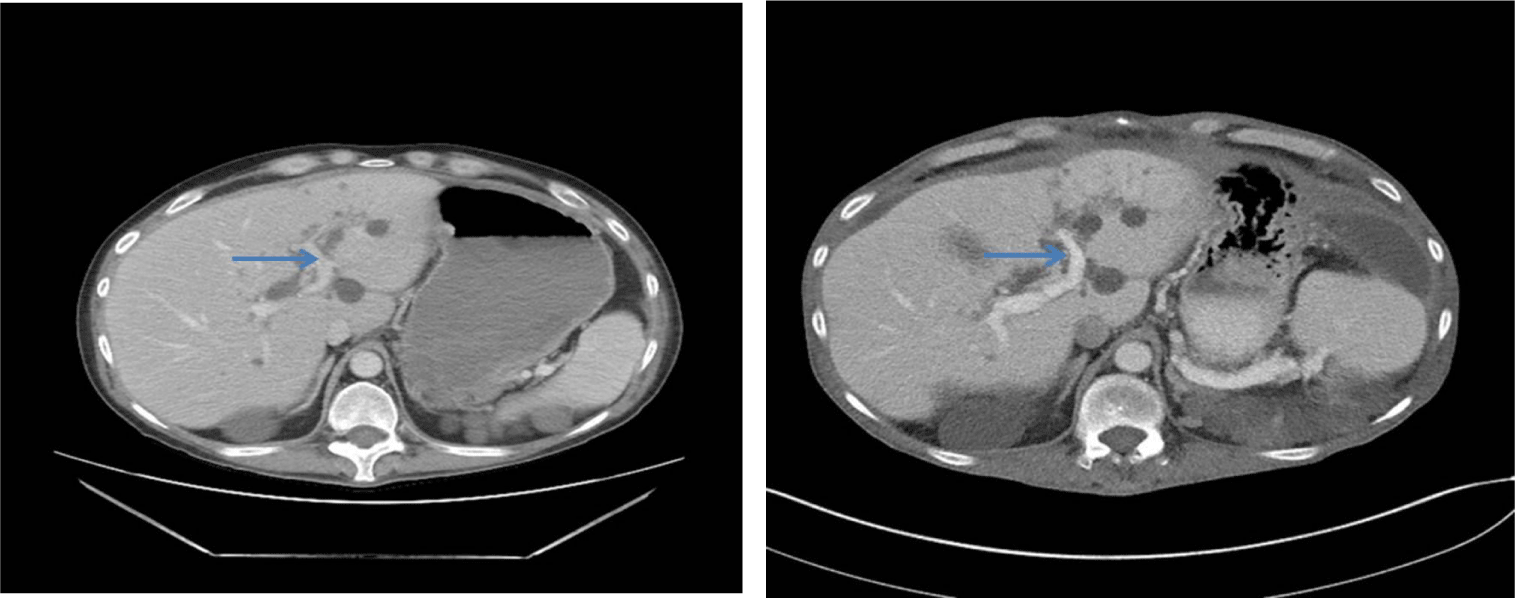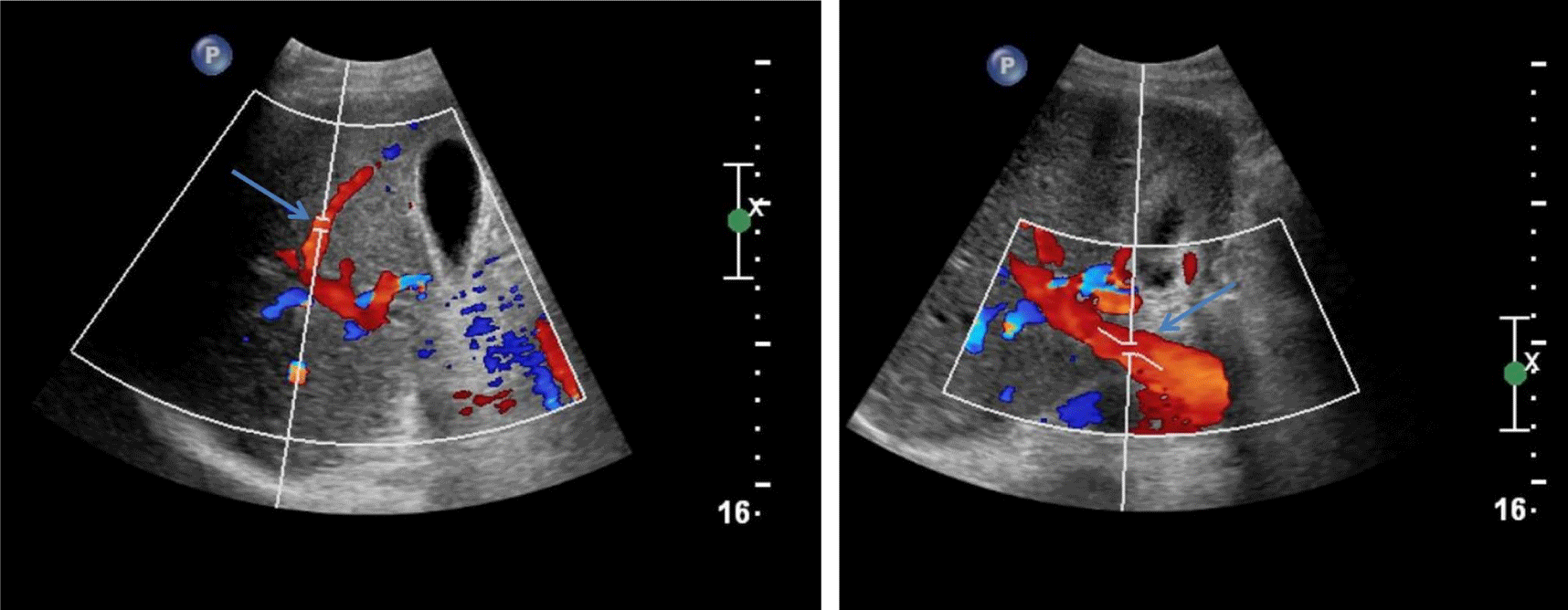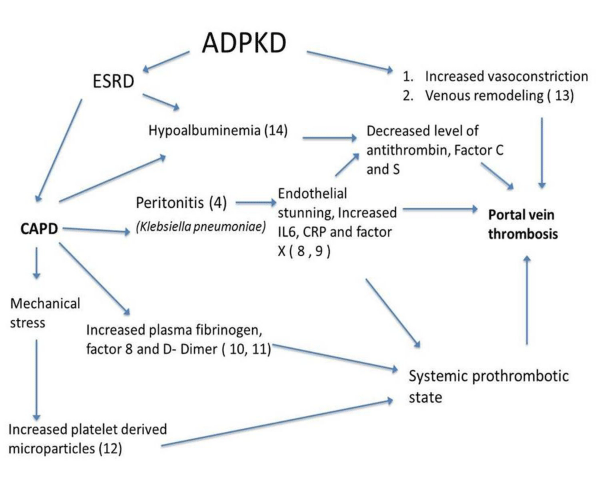Klebsiella pneumoniae Peritonitis could be a Potential Risk Factor for Portal Vein Thrombosis in Patients on Peritoneal Dialysis- a Case Report?
Hassan Bin Attique1, Ruchir Trivedi2, Snehal Naik3, Attiya Haroon4 and Charan Singh5
1Fellow, Division of Nephrology, Department of Medicine, MC1405 / L4045, University of Connecticut 263 Farmington Avenue, CT, 06032, USA
2Assistant Professor, Division of Nephrology, Department of Medicine, MC1405 / L4045, University of Connecticut 263 Farmington Avenue, CT, 06032, USA
3Hospitalist, Department of Medicine, Department of Medicine, MC1405 / L4045, University of Connecticut 263 Farmington Avenue, CT, 06032, USA
4Research Fellow, Rutgers Robert Wood Johnson Medical School, Department of Medicine, MC1405 / L4045, University of Connecticut 263 Farmington Avenue, CT, 06032, USA
5Assistant Professor, Division of Radiology, Department of Medicine, MC1405 / L4045, University of Connecticut 263 Farmington Avenue, CT, 06032, USA
*Address for Correspondence: Ruchir D. Trivedi, Assistant Professor (Nephrology), Division of Nephrology, Department of Medicine, MC1405 / L4045, University of Connecticut, 263 Farmington Avenue, CT, 06032, Tel: 860-679-2799; Ext: 2412; Fax: 860-679-3958; E-mail: rtrivedi@uchc.edu
Submitted: 07 September 2017; Approved: 13 September 2017; Published: 15 September 2017
Citation this article: Attique HB, Trivedi R, Naik S, Haroon A, Singh C. Klebsiella pneumoniae Peritonitis could be a Potential Risk Factor for Portal Vein Thrombosis in Patients on Peritoneal Dialysis- a Case Report. Int J Nephrol Ther. 2017;3(1): 035-039.
Copyright: © 2017 Attique HB, et al. This is an open access article distributed under the Creative Commons Attribution License, which permits unrestricted use, distribution, and reproduction in any medium, provided the original work is properly cited
Keywords : Klebsiella pneumoniae; Portal vein thrombosis (PVT); Peritonitis; Peritoneal dialysis (PD); Autosomal Dominant polycystic kidney disease (ADPKD)
Download Fulltext PDF
According to National Kidney Foundation data, more than 660, 000 Americans are being treated for End Stage Renal Disease (ESRD). Treatment options for ESRD include dialysis and renal transplant. Both Hemodialysis (HD) and Peritoneal Dialysis (PD) have similar efficacies and survival outcomes that represent therapeutic equipoise. PD is a home-based dialysis modality with distinct lifestyle advantages. Peritonitis is the leading complication of PD with 1 episode occurring in every 32.7 months. Gram-negative peritonitis constitutes 0.16 episodes/year; with klebsiella (K) species identified in 5.2% of culture-positive peritonitis cases. Infection associated hypercoagulability has been well described with systemic infections; but not with localized PD associated peritonitis. We present a rare case of K. pneumoniae peritonitis in an ESRD patient secondary to autosomal dominant Polycystic Kidney Disease (ADPKD) on PD complicated with Portal Vein Thrombosis (PVT). We also discuss possible etiologies involved in the pathogenesis of thrombosis.
Introduction
According to National Kidney Foundation data, more than 660, 000 Americans are being treated for End Stage Renal Disease (ESRD) [1]. Treatment options for ESRD include dialysis and renal transplant. Both Hemodialysis (HD) and Peritoneal Dialysis (PD) have similar efficacies and survival outcomes that represent therapeutic equipoise. PD is a home-based dialysis and it is a patient preferred and cost effective modality. Although, PD associated complications have decreased with the advent of new techniques, however peritonitis is still a major concern with 1 episode occurring in every 32.7months [2]. Gram-positive organisms such as staphylococcus aureus and staphylococcus epidermidis, are culprits causing peritonitis in almost half of all PD associated peritonitis cases [3]. Gram negative pathogens such as Klebsiella pneumonia, are infrequent (5%) cause of peritonitis in PD associated peritonitis [4], however, they carry significant morbidity and poorer prognosis compared to gram positive organisms.
We report a unique case of a patient with ESRD secondary to Autosomal Dominant Polycystic Kidney Disease (ADPKD), in which PD was complicated to Portal Vein Thrombosis (PVT) secondary to an episode of peritonitis. Gram-negative peritonitis associated with PD has not been a well-recognized risk factor for PVT. As PVT carries significant morbidity, timely recognition of this complication requires high index of suspicion. We further highlight other possible mechanisms involved in the pathogenesis of PVT secondary to ADPKD and ESRD.
Case Report
A 49 year old male on PD for past nine years presented in the emergency department after having cloudy effluent, pain during dialysate infusion with nausea and vomiting for last 24 hours. He denied any associated history of chest pain, palpitations, and shortness of breath, headache or dysuria. He had a known history of ESRD secondary to ADPKD. Patient appeared acutely ill but otherwise hemodynamically stable. On physical examination, abdomen was distended and diffusely tender with guarding and rigidity. Peritoneal fluid analysis showed cloudy effluent with white blood cell count of 3800/mm3 and predominant neutrophilia (95%) establishing diagnosis of PD associated peritonitis. Subsequent result suggested gram stain showing gram negative rods and peritoneal fluid culture rapidly became positive for K. pneumoniae. He was started on appropriate intra-peritoneal antibiotics (ceftazidime). PD catheter exit site and catheter tunnel did not have any visible or palpable sign of fluid collection or infection. After prolonged antibiotic treatment with intra-peritoneal antibiotic, intra-peritoneal heparin to break down fibrin and frequent peritoneal exchanges with lidocaine, patient’s clinical symptoms and PD fluid cell count started to improve. In spite of early signs of clinical recovery, we noticed worsening of abdominal distention, low grade fever and PD fluid leukocytosis (22600/mm3). Computed Tomography (CT) scan of abdomen with contrast revealed filling defect in portal vein suggestive of PVT as shown in figure 1. Heparin infusion was started. Serial CT scans and abdominal Doppler were performed to document resolution of PVT as shown in figures 2-5. Due to steady clinical improvement, radiological absence of portal vein thrombus and drop in hematocrit secondary to gastrointestinal bleed, decision to stop heparin after two weeks of therapy was made. Patient continued to recover in subsequent four weeks and was maintained on intra-peritoneal antibiotics. Markers for hypercoagulability remained negative.
Discussion
ADPKD is the most common autosomal dominant inherited kidney disorder; occurring in almost 1 in every 800 live births and is associated with renal and extra-renal, cystic and non-cystic manifestations. 50 -70% of patients with ADPKD end up with ESRD and require renal replacement therapy like Continuous Ambulatory Peritoneal Dialysis (CAPD) [5]. Peritonitis is one of the major complications of PD and is responsible for significant morbidity, loss of catheter, transfer to HD, loss of ultrafiltration and sometimes death [6]. The clinical outcome of PD peritonitis varies with the type of pathogen involved. In ESRD patients on PD, gram-negative peritonitis portends significantly worse prognosis as compared to gram positive peritonitis [6]. PD associated peritonitis caused by K. pneumonia can potentially cause rare complication such as PVT. K. pneumoniae liver abscesses can be complicated with coexisting thrombophlebitis of portal and hepatic veins in almost one third of PD patients [7]. Figure 6 is our attempt to summarize possible mechanisms involved in hypercoagulable state associated with localized infectious process such as PD peritonitis based on the published scientific literature. Below is a description of four such select mechanisms:
Infection
Acute infections, more specifically intra-abdominal infections may be responsible for causing thrombosis. Several authors have proposed the term “endothelial stunning” for reference to inflammation and activation of the vessel wall. Infection derived up regulation of interleukin-6, acute phase reactant such C-reactive protein and tumor necrosis factor induced activation of Factor X can lead to thrombin generation and procoagulation [8,9].
Chronic Kidney Disease (CKD)
In setting of ESRD, unfavorable risk factors such as uremic toxins, hypertension, systemic atherosclerosis, atrial fibrillation and pro-inflammatory milieu as suggested by elevated ferritin can all contribute to greater preponderance for hypercoagulability. In addition, PD may predispose to systemic prothrombotic state. Potential explanation may include increase in levels of prothrombin fragments F1+2, whereas increased activity of activated factor VII, D-dimer, tissue plasminogen activator antigen and activity as well as plasminogen activator inhibitor type 1 antigen And activity [10,11]. Another area of developing research interest include potential role of Platelet Derived Micro-Particles (PMP). These micro-vesicular particles are released in response to shear stress on platelet and are found in increased concentration in ESRD. PMP have endogenous prothrombinase activity rendering them procoagulant. It has been postulated that changes of PMP release might contribute to the pathogenesis of intra-dialyzer coagulation and vascular access thrombosis in HD patients as well [12]. In spite of number of plausible mechanisms that can explain procoagulant state in patients with ESRD, net increase in clinically meaningful thrombosis has not been well recognized.
Systemic vasculopathy
ADPKD may be associated with arterial and venous occlusions at a mean age of 51.2 years, which is early as compared to the healthier population. Various pathophysiological phenomenon involved in this process such as enhanced vasocontraction with arterial and venous remodeling, as shown in Pkd2+/− (mouse orthologous model of ADPKD) conduit and resistance arteries, may increase the risk for arterial and venous thrombosis [13].
Hypoalbuminemia
Hypoalbuminemia secondary to decreased albumin synthesis and increased trans-peritoneal albumin loss in patients on PD may also be a risk factor for thrombosis. Hypoalbuminemia not only affects blood viscosity or endothelial cell function as a result of increased concentration of free lysophosphatidylcholine altering erythrocyte structure but also causes increase in fibrinogen and factor VIII levels and decrease in anti-thrombin, protein C and S, hence creating a hypercoagulable state [14]. Clinical significance of this is presently unclear.
Our case was successfully treated with intra-peritoneal antibiotic therapy and short (two weeks) duration of heparin drip with complete resolution of peritonitis and portal vein thrombosis.
In conclusion, this case demonstrates that clinician should maintain high index of suspicion for thrombosis involving systemic and portal circulation in patients with intra-abdominal or PD associated infection.
Acknowledgement
All Authors had access to the data.
Dr. Hassan was involved in clinical care and compiling case report.
Dr. Attiya was involved in literature review and initial draft of manuscript.
Dr. Singh was involved in image retrieval.
Dr. Naik and Dr. Trivedi wrote the final version of manuscript.
- National Kidney Foundation. End stage renal disease in the United States. https://goo.gl/8t7Leb
- Brown MC, Simpson K, Kerssens JJ, Mactier RA; Scottish Renal Registry. Peritoneal dialysis-associated peritonitis rates and outcomes in a national cohort are not improving in the post-millennium (2000-2007). Perit Dial Int. 2011; 31: 639-50. https://goo.gl/k7MZ78
- Jacob A. Peritoneal dialysis associated infections: An update on diagnosis and management. World J Nephrol. 2012; 1: 106-122. https://goo.gl/q4rpss
- Wu TL, Lin WT, Chao CM, Lai CC. Spontaneous bacterial peritonitis caused by Klebsiella pneumoniae. OA Case Reports. 2013; 21: 123. https://goo.gl/akhiKp
- Molton, JS, Chee YL, Hennedige TP, Venkatesh SK, Archuleta S. Impact of Regional Vein Thrombosis in Patients with Klebsiella pneumoniae Liver Abscess. PLoS One. 2015; 10: e0140129. https://goo.gl/2zgMc4
- Lambrecht GL, Malbrain ML, Zachée P, Daelemans R, Lins RL. Portal vein thrombosis complicating peritonitis in a patient on chronic ambulatory peritoneal dialysis. Perit Dial Int .1994; 4: 282-283
- Liu J, Huang X, Liu Y, Xu H, Gong R, Li C. Analysis for patients with continuous ambulatory peritoneal dialysis associated peritonitis. Zhong Nan Da XueXueBao Yi Xue Ban. 2016; 41: 1328-1333. https://goo.gl/N3zLAc
- Bunke CM, Brier ME, Golper TA. Outcomes of single organism peritonitis in peritoneal dialysis: gram negatives versus gram positives in the Network 9 Peritonitis Study. Kidney Int. 1997; 52: 524. https://goo.gl/GPwiwc
- Wattanakit K, Cushman M, Stehman-Breen C, Heckbert SR, Folsom AR. Chronic kidney disease increases risk for venous thromboembolism. J Am Soc Nephrol. 2008; 19: 135-40. https://goo.gl/hswnzQ
- Jalal DI, Chonchol M, Targher G. Disorders of Hemostasis Associated with Chronic Kidney Disease. Semin Thromb Hemost. 2010; 36: 34-40. https://goo.gl/edPwL2
- Tichelaar YI, Kluin-Nelemans HJ, Meijer K. Infections and inflammatory diseases as risk factors for venous thrombosis. A systematic review. Thromb Haemost. 2012; 107: 827-37. https://goo.gl/LDfKxk
- Preloznik Zupan I, Sabovic M, Salobir B, Buturovic Ponikvar J. Characterization of the pro-thrombotic state in CAPD patients. Ren Fail. 2008; 30: 597-602. https://goo.gl/dJfMvX
- Ando M, Iwata A, Ozeki Y, Tsuchiya K, Akiba T, Nihei H, et al. Circulating platelet-derived microparticles with procoagulant activity may be a potential cause of thrombosis in uremic patients. Kidney Int. 2002; 62: 1757-63. https://goo.gl/DGQ2gs
- Qian Qi, Younge BR, Torres VE. Retinal arterial and venous occlusions in patients with ADPKD. Nephrol Dial Transplant. 2007; 22(6): 1769-71. https://goo.gl/Ym7W4n





Sign up for Article Alerts